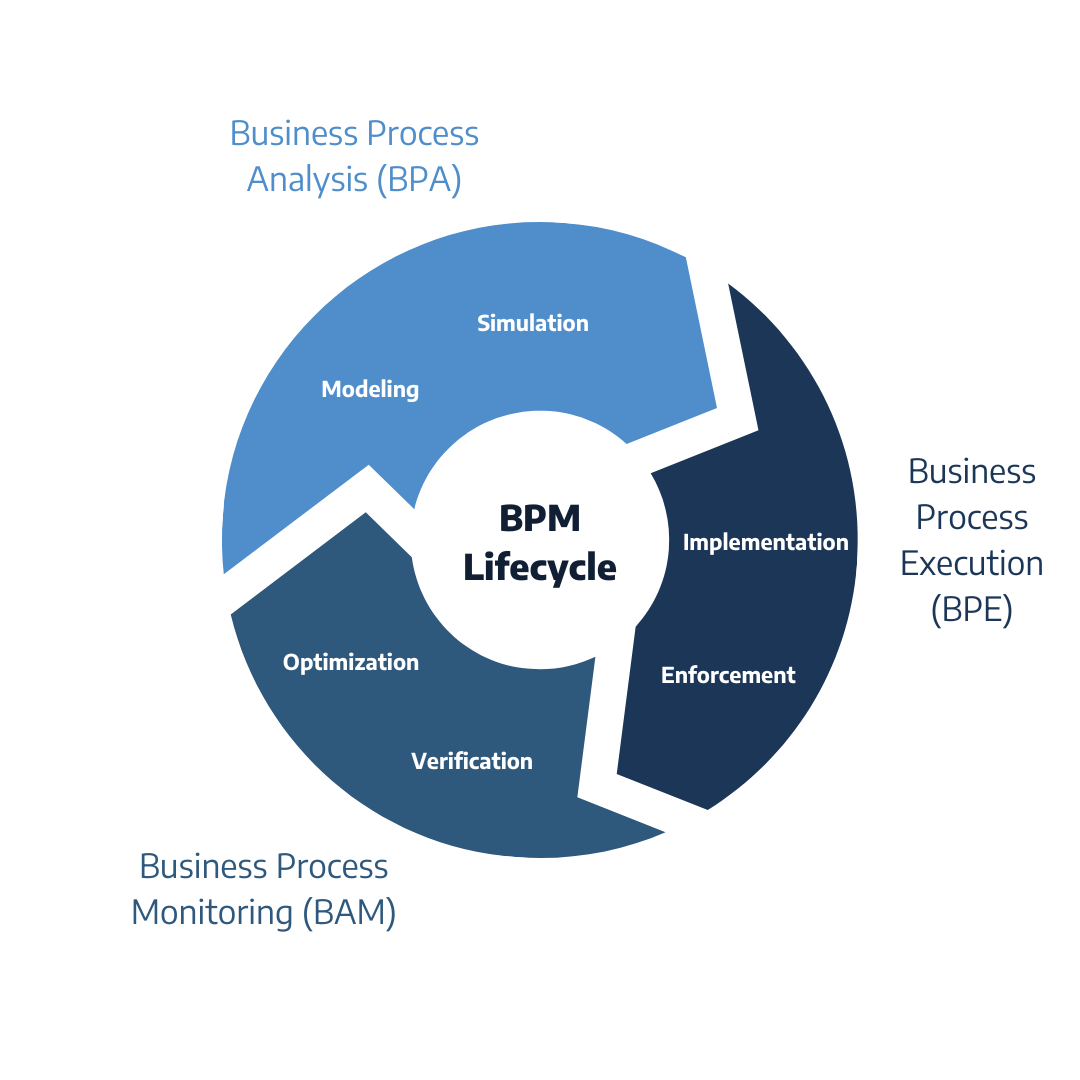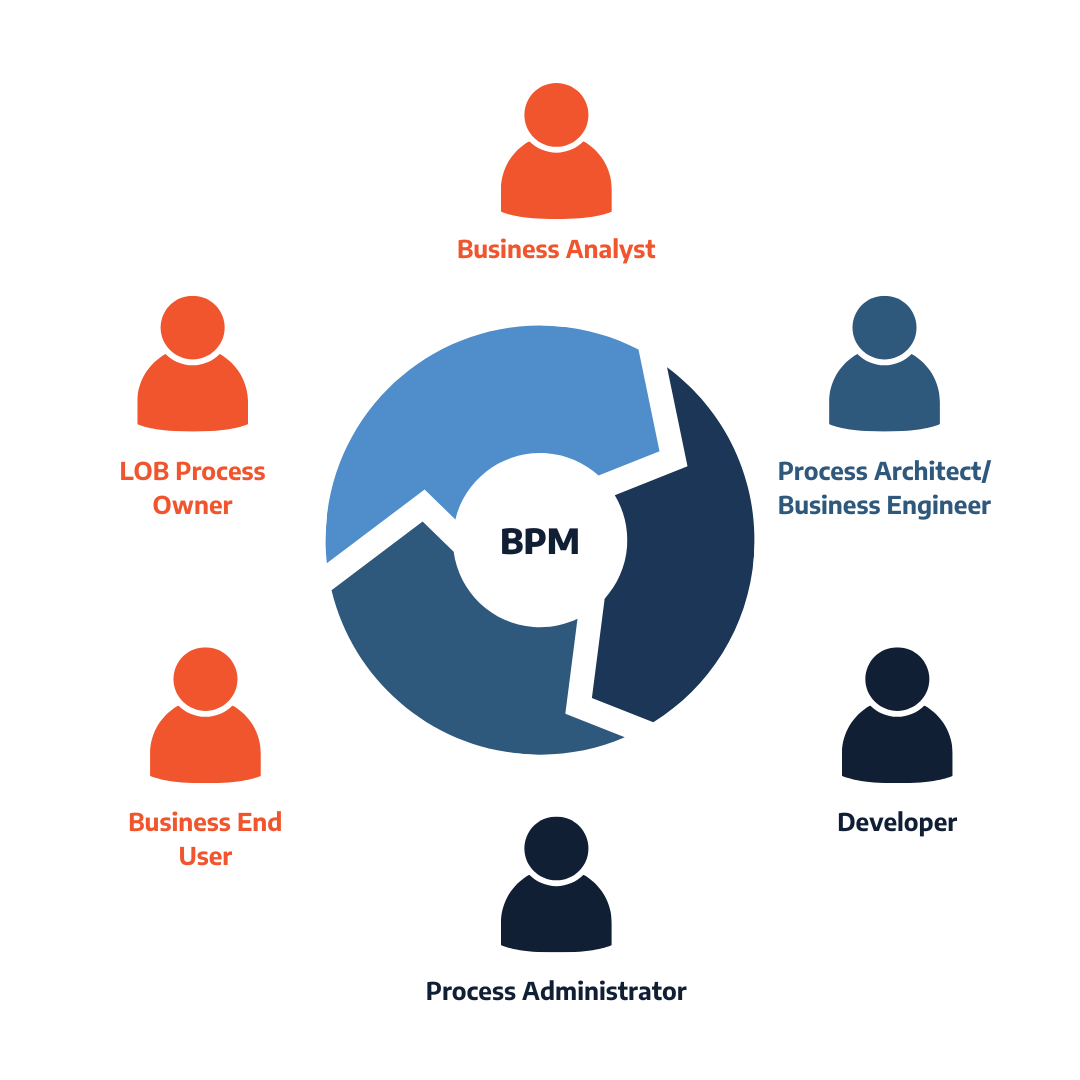
Business Process Management for d̶u̶m̶m̶i̶e̶s̶ conscious Managers
Written by Danubius IT Solutions
Business processes in general
In the world of business technology, digital transformation is not only a major task for senior executives, its implementation is essential for the effective functioning of the entire company. Gaps in paper-based management systems and the associated challenges such as difficulties in document management, data entry errors, lengthy approval processes and a lack of transparency in workflows increasingly require the search for and implementation of new, innovative solutions.
The first step is to evaluate the workflow in a given company and record the results. The aim is to understand the current processes, the ensuing steps, the individuals involved and the reasons for any possible inefficiencies. In a world where data-driven decision-making is key, acting on this information is increasingly important.
The second step is to implement a workflow management system (WMS). A WMS is an IT application that helps automate, track and manage workflows, allowing for internal processes to run more efficiently.
One of the central goals of implementing a WMS is to increase the transparency of business processes and reduce data entry errors. The system allows users to track all segments of the workflow in a well-structured way. This makes it easy to identify errors, including data entry errors, which helps to solve problems faster and more efficiently. It makes work faster and more accurate. The system automatically forwards the information to the notifiers. It can track process changes, their current status and duration, allowing you to measure and optimize the efficiency of each work phase. With WMS, new types of communication channels can be established between departments, expediting the flow of information between departments and staff, reducing information loss and thus strengthening coordination and collaboration.
The WMS should integrate with the company's existing IT systems and applications, such as ERP (Enterprise Resource Planning) or CRM (Customer Relationship Management). As a result, the company can operate in a unified and harmonized approach, which contributes to data-driven business management and the elimination of duplicate data entry.
In summary, the implementation of workflow management systems offers companies significant benefits: it promotes transparent organizational operations, reduces errors, improves speed and accuracy of work, enhances communication between units and facilitates system integration. Those that can exploit this potential will be able to gain a meaningful competitive advantage over rival firms.
Business Process Management
Business Process Management (BPM) is an integral part of modern business management systems. It is a technology used by companies to shape, simulate, automate, optimize and monitor their key business processes and plays an important role in increasing efficiency and productivity.
- It allows companies to shape their own business processes. With BPM tools, they can visualize these processes, defining and evaluating the relationships between various activities and steps. This ability allows them to better understand how their processes work and gives them the opportunity to make the necessary changes.
- Supports process simulation. This is a capability of BPM tools that allows you to examine your processes at the model level. This allows you to assess the impact of planned changes in advance, helping you to prevent unintended consequences and maximize returns.
- BPM tools can be used to automate business processes. Automation can reduce human error and increase work efficiency, leaving employees more time for more complex, higher value tasks.
- BPM helps us optimize our processes. This includes evaluating and refining business processes to make them more efficient and effective, eliminating redundant steps, streamlining workflows and using resources more efficiently.
- BPM ensures the monitoring of processes. Process monitoring and reporting functions help the organization to monitor its performance and identify potential problems in a timely manner.
With BPM technology, companies can reduce costs and increase productivity, which can bring on significant business benefits. The use of BPM is not only cost-effective, it is also strategic, enabling its users to better adapt to the changing business environment, proactively addressing challenges and opportunities. Business flexibility and agility is key in today's competitive economy.
Definitions needed for process management
To understand the essence of BPM, we need to be aware of the following concepts:
Business Process (BP)
A business process is a set of interrelated, structured activities or tasks that produce a particular service or product for a customer or client. These activities are usually based on the business model, customer needs and industry specific requirements. Processes may be automated or self-executed, interlinked and form process nets. They may reference other processes in return for referencing them from other processes.
Business Process Modeling and Notation (BPMN)
BPMN (Business Process Modeling and Notation) is a graphical model that can be used to represent business processes. It can also be used to generate BPEL for direct implementation. BPMN can be used not only to model business processes, but also to execute and even control them as well. It has been developed with a description that is clear and understandable to all business users, developers and analysts.
Business Process Diagram (BPD)
BPD is also a graphical representation that uses different diagrams to represent activities, events and relationships in business processes.
The benefits of business process management
BPM helps to identify the business processes that are key for the company, gives tools to design and implement new models and modify the old ones to increase the efficiency of the company.
With the help of BPM modeling, the business process can be optimized and modified at any time.
BPM accelerates the flow of information, allowing the company to react more quickly to market changes and competitors' strategic moves. BPM uses the same business terminology and process repository, giving stakeholders a common language and modeling methodology.
There is usually a gap between the IT and business segments. BPM, on the other hand, can bridge the gap between IT and the business by matching the business processes that can be executed with the business requirements in the model.
Non-automatic documentation will incur additional costs. Business process management tools, on the other hand, not only document automatically, but also produce reports, which is important in complying with regulations and standards.
Where similar business processes are performed in two different departments, at the same time and with some variation, BPM can detect and identify these processes and minimize the differences between them.
The business process management lifecycle
Organizations that want to stay competitive need to manage their business processes. This requires the systematic use of the entire lifecycle of BMP. The main components of the BPM lifecycle are Business Process Analysis (BPA), which performs the modeling and simulation, Business Process Monitoring (BAM), which controls the business processes, and Business Process Execution (BPE), which is the tool for executing the business processes.

The lifecycle of a general business process management consists of 3 parts:
Business Process Analysis
BPA includes modeling and simulation. Modeling is used to design business process models with their own iterative life cycle. Business people can collaborate to find what is most important to them in areas such as business processes and policies, key performance indicators, or business events and activities. This is followed by simulation and analysis of models to optimize them to increase flexibility and reduce risk. In the simulation phase, the performance of the model is measured by specifying various cost and time factors. A number of "what if" cases can be analyzed in a similar way.
Business Process Execution
The next phase is implementation and enforcement. Business process models are abstract and need to be converted into concrete, executable processes that can be used on real-time platforms. Business process management brings IT and the "business" closer together, so that business processes and requirements that are already executable are merged into business process models.
Business Process Monitoring
Verification and optimization is the third phase. This activity provides real-time visibility, i.e. real-time quantified business metrics from processes, systems and other sources. In addition to greater visibility, real-time analysis is also possible, facilitating informed decision-making. Intervention can be made at the design stage, but the process can also be changed at the implementation stage (during its operational lifetime) without having to redesign the entire solution. For the business process to evolve - to run the simulation in our model based on real numbers - we need to continuously provide the necessary quantified business data, optimization can be done later, after which we can reorganize the business process model.
People involved in business process management

The Business Process Management lifecycle is made up of IT and business "segments" that need to work together to create the perfect business process.
Tasks of people involved in business process management
Persons concerned | Descriptions | |
LOB Process Owner | Owns business processes, sets goals and business requirements. | |
Business Analyst | Responsible for creating and analyzing business process models. Runs simulations to achieve optimal business process models. | |
Business End User | An everyday user of business processes. | |
IT Developer | Takes abstract business processes and turns them into executable and verifiable business processes. | |
Process Administrator | Monitors and manages the processes that have already been transformed. | |
Process Architect/Business Analyst | Responsible for effective collaboration between business and IT organisations. | |
The workflow management system
Workflow Management Systems (WMS) are essential tools for the digital age. In the business world, technological advances to improve workflow efficiency play a crucial role in business success: a workflow management system makes it possible.
Similar to a highway, a workflow system provides a route for tasks and activities. This route is planned in advance, defining where to go, where the exits, rest stops, databases, applications and services are. The highway is a symbolic example of how a well-designed workflow system works, ensuring that tasks and activities only proceed along the designated path, at the right time and in the right order.
It is imperative to understand that a workflow management system is not simply an administrative tool. It's not just about capturing and storing data - that's the job of the associated business system. In fact, the workflow system is not used to store data, but to manage workflows in real time. When defining a workflow system, the focus is not on the technical implementation, but on the logical steps relevant to the business processes. Each step represents a task to be performed in a timely manner. This task could be a decision, checking a document, or even sending an email. The bottom line: tasks must be completed at the proper time in the process, not too early and not too late.
Precise timing of tasks in a well-designed workflow system allows workflows to run smoothly. Should someone complete a task too early or too late, it can cause chaos in the workflow and negatively affect other actors. In addition, if the timing of tasks is poor, work done earlier can quickly become obsolete. Therefore, one of the most important functions of a workflow system is to control processes in real time and monitor the timing of tasks. The system monitors the sequence of activities, the use of resources and tracks the progress of workflows. The automated workflow management system is able to send notifications to users about upcoming tasks and updates the project schedule by scheduling the completion of tasks. The implementation of a workflow system is therefore an essential tool for the efficient management of workflows. However, like any IT system, a workflow system requires necessary maintenance and development to meet the changing business requirements of the company. IT professionals must constantly monitor the performance of the system and be able to optimize and update it on an ongoing basis.
Workflow management systems are technology tools that help companies manage their workflows more efficiently. They facilitate the automation of tasks and activities, work scheduling and project management, and enable companies to better manage their workflow, improve efficiency and increase productivity.
Types of workflow management system:
A document-centric workflow, such as Captiva, where the central element of the process is a document or set of documents, can be implemented quickly and does not require IT expertise to design. It is ideal for small group, document-centric workflows, with ready-made or semi-ready user interfaces. It generally has poor control-flow capabilities, incomplete support for transaction management and calling background systems or services, and limited customisation of user interfaces.
An application-centric workflow, such as SAP, offers a built-in workflow engine for a specific enterprise application suite (typically ERP systems). This type provides flexibility to manage processes within the existing ERP application and does not require a separate process engine, offering a cheaper solution. However, it also has shortcomings, such as poor control-flow capability, lack of transaction management to external data sources, difficult integration with external systems and limited customizability.
Collaborative workflow, such as Lotus Domino or Sharepoint, offers a less formalized, human-centered implementation. It provides a high degree of flexibility in scaling up the process and new processes can be developed quickly. Collaborative workflow offers poor control-flow capabilities, lacks transaction management and is often challenging to integrate with external systems. In addition, its high flexibility does not enforce compliance.
A transaction-centric workflow uses a strictly formalized sequence of transactions (or human steps). It allows easy integration with external systems and services, offers transaction-proof operation and has strong control-flow capabilities. This type of workflow system offers a robust solution, but its drawbacks include the need for expertise to develop workflows, its rigid and formalized operation, and often poor support for user interfaces or human interfaces.
This article was written by Bálint Horváth, System Analyst at Danubius IT Solutions.
Interested in IT solutions tailored to your business? Contact us for a free consultation, where we'll collaboratively explore your needs and our methodologies.

.png?alt=media&token=6167f0c8-f152-4da9-8498-30e472899817)
.jpg?alt=media&token=7f5e6011-729e-4df8-bbe4-e97d3ab885a8)

